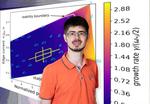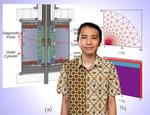Other

“Researchers at the U.S. Department of Energy(Link is external)’s (DOE) Princeton Plasma Physics Laboratory (PPPL) measured a new record for a fusion(Link is external) device internally clad in tungsten, the element that could be the best …

“Emerging research suggests it may be easier to use fusion as a power source if liquid lithium is applied to the internal walls of the device housing the fusion plasma. Plasma, the fourth state of matter, is a hot gas …
News Plasma scientists develop computer programs that could reduce the cost of microchips and stimulate American manufacturing

“Fashioned from the same element found in sand and covered by intricate patterns, microchips power smartphones, augment appliances and aid the operation of cars and airplanes. Now, scientists at the U.S. Department of Energy’s (DOE) Princeton Plasma Physics …

“Physicists at the U.S. Department of Energy’s (DOE) Princeton Plasma Physics Laboratory (PPPL) have proposed the source of the sudden and puzzling collapse of heat that precedes disruptions that can damage doughnut-shaped tokamak fusion facilities. Coping with the …
News Smaller, stronger magnets could improve devices that harness the fusion power of the sun and stars

“Researchers at the U.S. Department of Energy’s (DOE) Princeton Plasma Physics Laboratory (PPPL) have found a way to build powerful magnets smaller than before, aiding the design and construction of machines that could help the world harness the …
News Researchers design simpler magnets for twisty facilities that could lead to steady-state fusion operation

“Harnessing the power that makes the sun and stars shine could be made easier by powerful magnets with straighter shapes than have been made before. Researchers linked to the U.S. Department of Energy’s (DOE) Princeton Plasma Physics Laboratory …
News PPPL scientists create insights into perhaps the most extreme state of matter produced on Earth

“Exotic laser-produced high-energy-density (HED) plasmas akin to those found in stars and nuclear explosions could provide insight into events throughout the universe. Physicists at the U.S. Department of Energy’s (DOE) Princeton Plasma Physics Laboratory (PPPL) have discovered a …

“Think of light bulb filaments that glow when you flip a switch. That glow also occurs in magnetic fusion(link is external) facilities known as tokamaks(link is external) that are designed to harness the energy that powers the sun …

“A new method for verifying a widely held but unproven theoretical explanation of the formation of stars and planets has been proposed by researchers at the U.S. Department of Energy’s (DOE) Princeton Plasma Physics Laboratory (PPPL). The method …

“Bringing the power of the sun to Earth requires sound theory, good engineering, and a little finesse. The process entails trapping charged, ultra-hot gas known as plasma(link is external) so its particles can fuse and release enormous amounts of …

